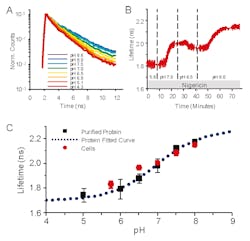Researchers engineer first ratiometric, single-protein red fluorescent pH sensor
Researchers from Harvard Medical School (Cambridge, MA) have engineered the first ratiometric, single-protein red fluorescent pH sensor. Called pHRed, the sensor will be used to image intracellular pH in live neuronal cells.
Led by Professor Gary Yellen, the team used spinning disk confocal technology (the Revolution DSD system from Andor Technology) to engineer pHRed. The team also established pHRed's capability to simultaneously measure intracellular adenosine triphosphate (ATP) and pH because of its spectral compatibility with a second ratiometric ATP sensor, green fluorescent protein (GFP)-based Perceval. The team also showed that pHRed provides a new tool for imaging pH in thick samples and in-vivo when imaged by two-photon fluorescence lifetime imaging microscopy (FLIM).
Sensitivity to pH is a critical problem for GFP-based sensors and can cause severe artefacts if not taken into account, says Yellen. But pHRed provides a simultaneous pH signal, which can be used to correct the pH sensitivity of a green sensor. What's more, optical sectioning with excitation ratio-imaging enables access to intracellular compartments and organelles.
The team's achievement builds on the increasing interest in genetically encoded fluorescent indicators (GEFIs) for live-cell microscopy, according to Dr. Mark Browne, director of systems at Andor Technology.
